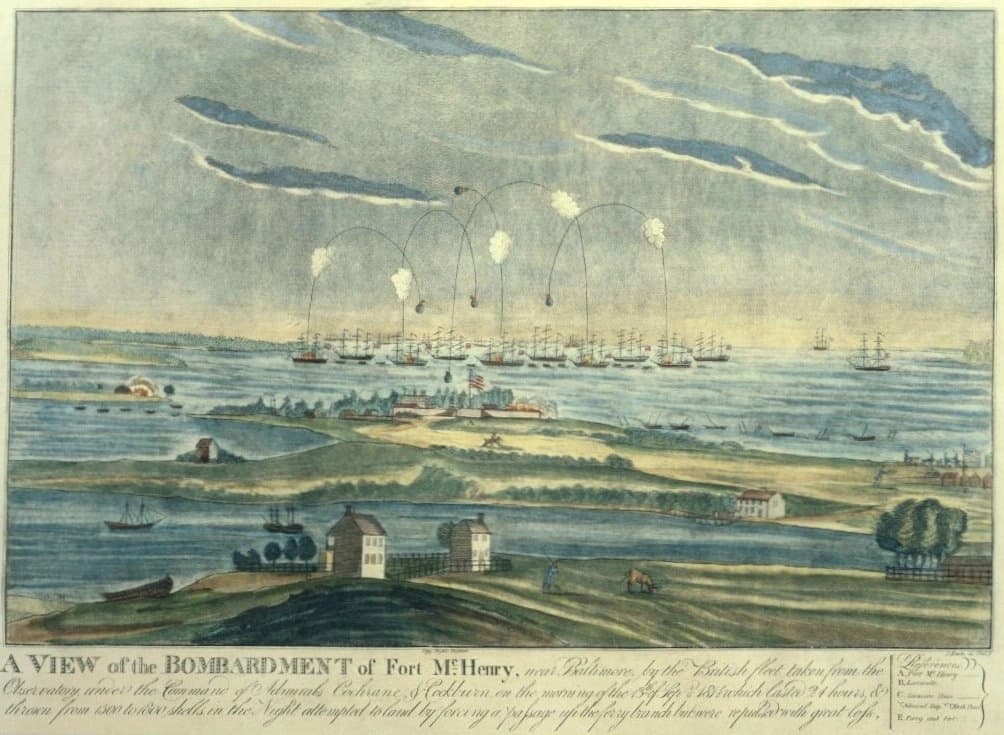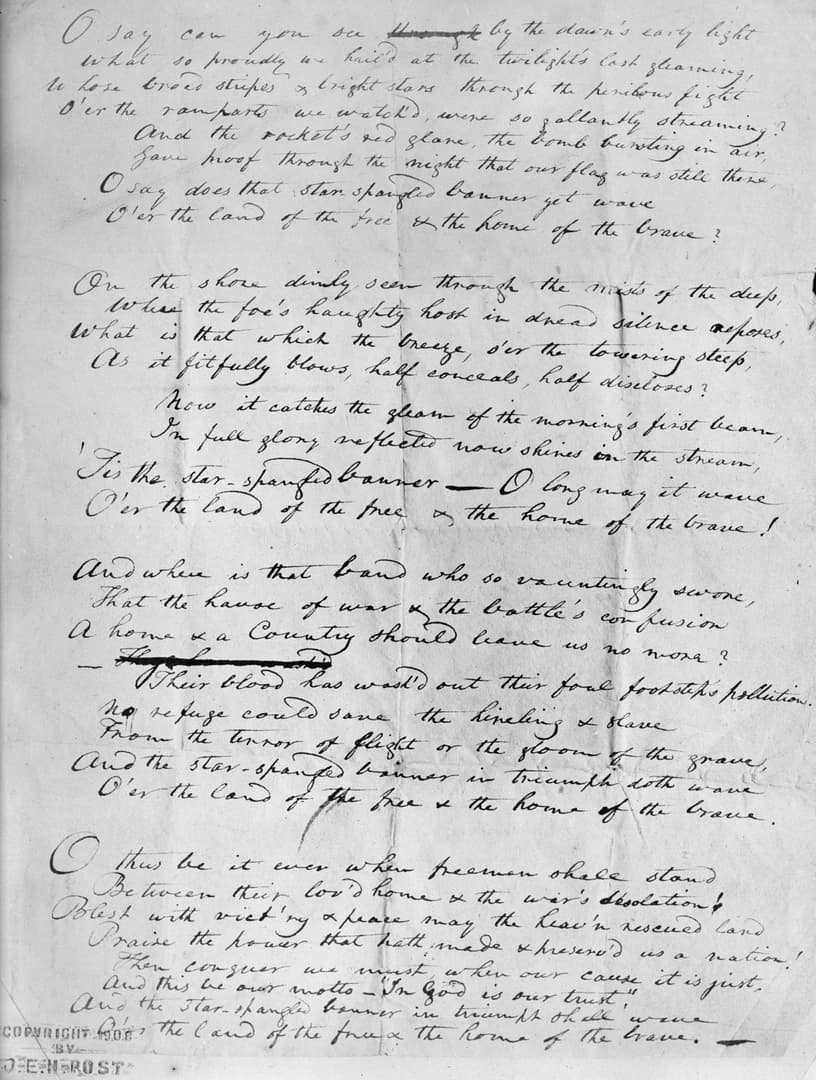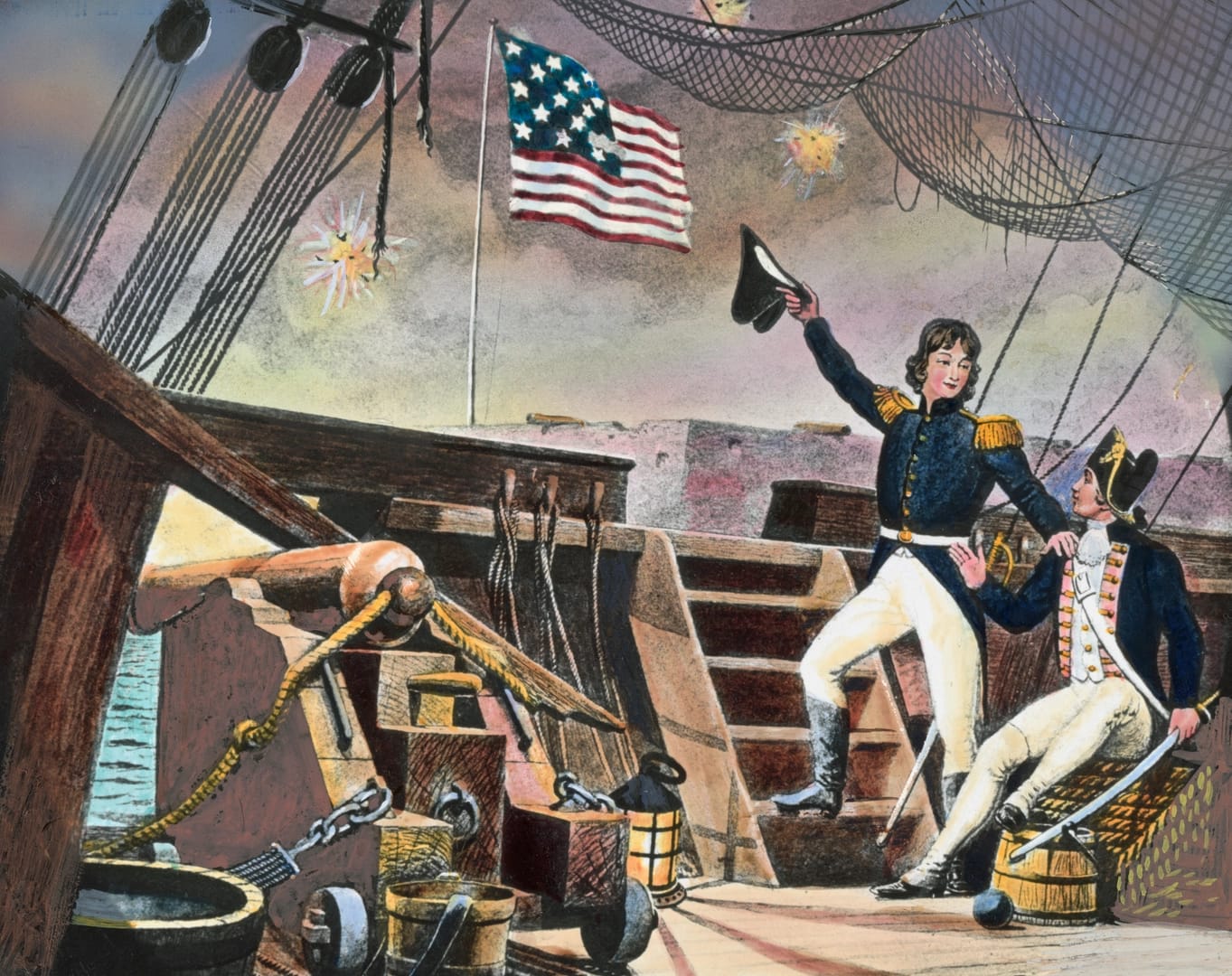One of this year's more surprising news stories was around the collapse of the Francis Scott Key Bridge, named for the famed poet whose words became the lyrics of our national anthem, “The Star-Spangled Banner.” The Key Bridge was built near the site of a major battle in the War of 1812—the Battle of Baltimore. On September 13, 1814, the British bombarded Fort McHenry with shells and rockets for over 24 hours, as Key himself looked on. Just weeks earlier, the British had torched the Capitol, the Treasury, and the President’s house. The future of the United States was once again uncertain.

“A View of the Bombardment of Fort McHenry,” aquatint by John Bower, published circa 1814. Image courtesy of Dr.frog at en.wikipedia, Public domain, via Wikimedia Commons.
At the time, Key was a young, prominent Georgetown lawyer. The morning of that fateful September day, Key and John Stuart Skinner, the U.S. Agent for Prisoners of War, boarded a British ship to negotiate the compassionate release of Dr. William Beanes, an elderly American civilian who was suspected of being a spy. They were successful in their negotiations, but the British decided that Key and his colleague had already seen too much to be released, and feared that they could report on British ship positions. The three men were allowed to return to their ship, but it was tethered to a British vessel and placed under guard. As night fell, British ships were fast closing in on Fort McHenry, preparing to bomb it to oblivion, as they had done in Washington.
As dawn rose after 25 harrowing hours of continuous bombardment, Key glimpsed the American flag through the smoke, in awe that Baltimore had been saved. He immediately turned his inspiration into words as “The Defense of Fort McHenry,” later renamed “The Star-Spangled Banner,” which he apparently scribbled onto the back of an envelope.

A manuscript of Francis Scott Key’s lyrics to “The Star-Spangled Banner.”
Soon after, the poem was published with instructions to sing it to the tune of “To Anacreon in Heaven,” the popular signature ditty of a London gentleman’s club, the Anacreontic Society, which was frequented by amateur musicians. For over a century, the identity of the composer was a mystery until the 1970s, when it was finally recognized to be the work of British(!) composer John Stafford Smith. With lyrics by the society’s president Ralph Tomlinson, the song was intended as an ode to the Bacchanalian spirit of Greek poet Anacreon. It was customarily sung to mark the shift between the evening’s orchestral concert and the after-dinner communal singing. To listen to the tune, click here.
For decades, “To Anacreon in Heaven” circulated as a broadside, a cheap edition of a song printed on a single sheet of paper that sold for pennies. The “Anacreon” melody was used as a vehicle for all sorts of different lyrics that spoke to the issues of the day, including political scandals, abolition, and even temperance. Key probably got the idea to use the tune from the popular song “Adams and Liberty,” which was set to the same music and was used to promote John Adams, the country’s second president.
![By Thomas Carr (arranger) - C[arr], T[homas] (arr.) (1814) The Star Spangled Banner: a Pariotic Song, Baltimore: Carrs Music Store, Public Domain, https://commons.wikimedia.org/w/index.php?curid=91894505](/_next/image?url=https%3A%2F%2Fimages.ctfassets.net%2F8usdt07j8s00%2Fg52FFa7zjFoV9kCQUdW4z%2Ff86b7e52763d3f39890976a254793e4a%2FStar_Spangled_Banner__Carr___1814_.webp&w=1920&q=75)
The earliest surviving sheet music for “The Star-Spangled Banner,” dated 1814, the year Francis Scott Key penned the words. Courtesy of Wikimedia Commons.
During the Civil War, “The Star-Spangled Banner” became a symbol of patriotism both for the North and the South. On the Fourth of July in 1861, the first year of the War, physician and writer Oliver Wendell Holmes penned additional lyrics that became an unofficial fifth verse. Holmes wrote of “millions unchain’d who our birthright have gained,” as he looked ahead to a time when the United States would fulfill its ideals by ending slavery and creating a truly equal society. Meanwhile, the South claimed Francis Scott Key as a Southern slaveholder. Holmes’s version (below) circulated widely during the Civil War and beyond, especially in Northern newspapers:
When our land is illum'd with Liberty's smile,
If a foe from within strike a blow at her glory,
Down, down, with the traitor that dares to defile
The flag of her stars and the page of her story!
By the millions unchain'd who our birthright have gained
We will keep her bright blazon forever unstained!
And the Star-Spangled Banner in triumph shall wave
While the land of the free is the home of the brave.
In 1889, the U.S. Navy recognized “The Star-Spangled Banner” as the official tune for raising and lowering the flag, and Woodrow Wilson decreed it the national anthem of the armed forces in 1916. Famed band leader John Philips Souza and conductor Walter Damrosch assisted in preparing an official arrangement for use by the army and navy that went into circulation in 1917. Finally, “The Star-Spangled Banner” became the official national anthem under Herbert Hoover on March 3, 1931.
Key’s powerful words still speak to the resilience of a nation that has persisted against all odds.







